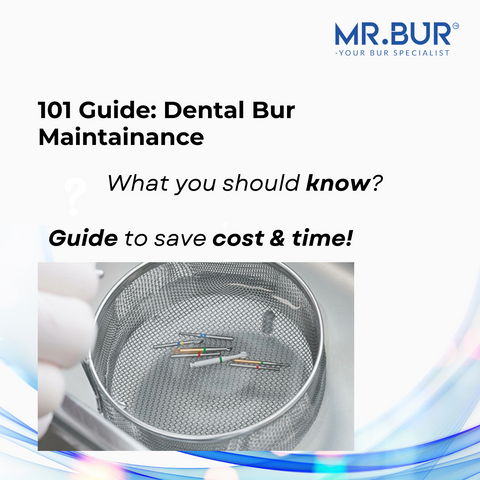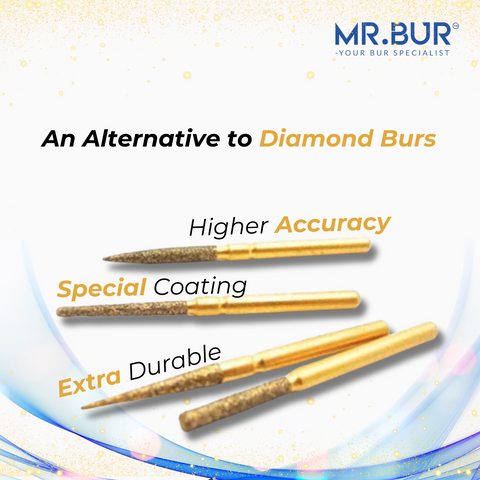A: You can start from the 4 following solutions.
-
The impeller will run under resistance if the dental handpiece is dropped and deformed. As long as it can be recovered in an appropriate way, the impeller can run flexibly.
-
Add some lubricating oil to the bearing if the bearing is running slowly.
-
Change the same type of bearing when the old bearing is damaged.
-
When the air pressure is too low, adjust the pressure to ensure that it keeps within 2. 0~2.5kgf /cm2, then speed will return to normal.
What do I do if the bur of dental handpiece keeps falling out?
A: You can start from the 4 following solutions.
-
Notice the allowed speed range to avoid a cutting load greater than the clamping force.
-
Use a short bur with a mini head, or it is easy for long burs to fall out.
-
Do not use worn burs, bent burs, or burs without a cutting edge. Otherwise this will affect the durability of the bearing and potentially cause damage to the patient.
-
The bur must be pulled after the installation to confirm that it has been installed firmly. If not inserted deep enough, the bur will fall out easily.
What do I do if the water supply is not smooth?
A: This is a common problem of dental handpieces. For pneumatic high speed turbine handpieces or contra angle handpieces, if water supply is abnormal such as insufficient water supply, non-uniform water supply, no water mist formation or completely no water supply, there are generally four following reasons and please check them first.
Check the parts where water is possible to be blocked
-
Pipeline: Remove the turbine handpiece and check whether there is water flowing out in a proper amount. If there is no water flow, it could be a problem in pipeline or water supply system of integrated treatment station (poor contact, misoperation, or low water pressure).
-
Joint: Test the connecting pipeline in joints. If there is no water flow, it could be a problem in the joint (water scale blocking the water supply system or loose joint, leading to low water pressure).
-
Handpiece body: Remove the spindle from the turbine and then install a joint. If there is no water flow, it could be a problem in the turbine handpiece body (water supply port blocking by dirt or water supply system blocking inside the turbine handpiece)
-
Spindle: If water flows normally in the above 3 conditions, it could be a problem in spindle (nozzle blocking).
What is a low speed dental handpiece used for?
A: Driven by compressed air, it rotates and holds the low speed bur to achieve drilling, polishing and cutting treatment.
Low speed handpieces are divided into straight handpieces and contra angle handpieces. The straight ones are used for polishing in extra oral treatment and the contra angle ones are used in intraoral treatment.
A: According to the working modes of used bearings, dental handpieces are divided into ball bearing ones and air bearing ones. High speed ball bearing handpiece is mainly composed of head, handle and joint.
-
The inner structure of handpiece head A turbine rotor is the core component of the head and is composed of a bearing, impeller and spindle. Inside the head, there are two miniature bearings distributed on the top and bottom, respectively. The O-shape rubber rings are equipped outside the bearings to keep the radial and axial concentricity of bur during high speed rotating. In addition, this can also decrease noise and reduce vibration during operation.
-
Holding mode of bur There are various holding modes of burs and the early used is reed holding mode. 3 bow reeds are distributed uniformly inside the spindle and when bur shank is inserted in, the reeds are deformed by force so that the bur shank is clamped. Nowadays, screw and pressing type holding modes are more commonly used. For this kind of handpiece, an elastic trivalve spring is equipped inside the shaft sleeve. The spring is hammer shaped and there are 3 axial grooves on it. By using four angle wrench, we can press the top spring to loosen the bur or lock the spring to hold it.
-
Spray structure A branch water pipe and air pipe are equipped on the end of the turbine handpiece. Water and air are mixed at the exit of the head and then sprayed out of spray hole.
- Handpiece joint The joint is the connecting part of the handpiece and output hose. The main dynamic airflow that drives the impeller rotating and the branch airflow that forms spray flow through pipes into the main air hole, branch air hole and water hole on the joint respectively and then flows though the handpiece. There are two methods for the connection between joint and handpiece: one is the use of a fixed lock nut on joint and the other is the use of a quick connector.
At MR. BUR US, we ensure unwavering quality and safety through strict compliance with all relevant regulations.
Choose your handpiece now:
https://www.mrbur.com/products/turbo-5-handpiece-series
Diamond Burs, Carbide Burs, Surgical & Lab Use Burs, Endodontic burs, IPR Kit, Crown Cutting Kit, Gingivectomy Kit, Root Planning Kit, Composite Polishers, High Speed Burs, Low Speed Burs
Subscribe our newsletter now!



